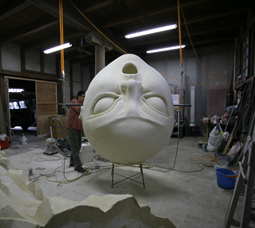 |
|
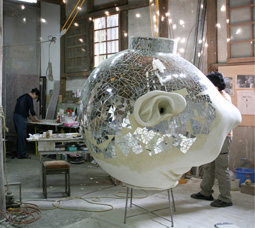 |
|
|
|
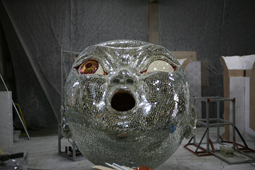 |
|
 |
| Three stages in the construction of Earth Baby at Hynoco Studio in Iruma, 2009, and (lower right) an installation view of Earth Baby at the Busan (South Korea) Biennale, 2010. All images © Tomoko Konoike |
Tomoko Konoike has achieved considerable visibility in recent years with paintings and sculptures that are dramatic in scale and unorthodox in motif. Her images are the stuff of myths and dreams -- six-legged wolves, planet-like baby heads, butterflies walking on human legs, mountains with faces. Many of her recurring motifs suggest a merging of the human and the non-human: Konoike seems to be striving for a level of consciousness beyond or beneath the human veneer.
That is the theme, in fact, of one of Konoike's most moving works -- not a painting or a sculpture but a picture book translated into English as Book Burning: World of Wonder (Hatori Press, 2011). Her illustrations -- of a series of open tomes erupting with apocalyptic imagery -- accompany a poem-like narrative that traces the cosmic journey of Imagination as an independent force predating the birth of the universe. It temporarily resides in the human mind, but when our world comes to an end, "weary of playing with terrestrial gravitation / Imagination set out on a wild journey / Leaving behind all notion of words." (Translation by Ginny Tapley Takemori)
Konoike also writes elsewhere of her desire to get to the primordial essence of things beyond language. The archetypal quality of the motifs that crop up in her work reflects this. "The images that appear in my art are not thought out," she says. "They come to me at unexpected times. Sometimes I carry them around in my head for years before I have a chance to make something of them." Thus while critics are quick to read sociopolitical, feminist, or ecological messages into her work, Konoike declines to encourage such interpretations.
Konoike describes herself as someone who enjoyed making things but found it difficult to speak as a child. As an adult, however, she discovered the pleasure of "playing around" with words and came to appreciate their power for manipulation and obfuscation. Words, she says, are an "attractive tool" and an essential one in the marketplace. "If I feel the need to persuade a client of the suitability of one of my images for, say, a work of public art, I might try to come up with an appealing narrative after the fact -- one that is not necessarily what occurred to me when I first sketched it out."
Indeed, she claims to actually relish the Byzantine process that goes into producing a public sculpture on commission, involving interactions not only with corporations and architects, but with the artisans she must rely on to build, first a mockup of the sculpture, then the work itself. It's a less isolating procedure than painting, she says. She also likes being able to create "large pieces that will be exposed to the elements, not confined to the security of a gallery." Konoike did not make a name for herself as a painter and sculptor until well along in a career as a toy designer. "Toymaking is much like sculpture-making," she notes. "The process -- from sketch to model to factory -- is the same, and so is the ongoing exchange of opinion. I'm accustomed to that give-and-take and I enjoy it."
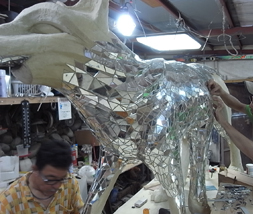 |
|
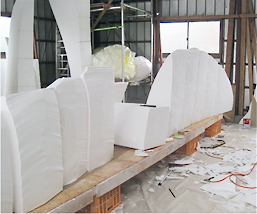 |
| Donning Animal Skins and Braided Grass under construction. One of Konoike's recurring motifs, the six-legged wolf, is covered with mirror tile by Kazunori Shionoya (left) and Syu Morita at Hynoco Studio, 2010. © Tomoko Konoike |
|
Chunks of Styrofoam await assembly into a life-size mockup of an outdoor sculpture at Hynoco Studio. Photo by Alan Gleason |
For the prototypes of her large-scale works, she has relied in recent years on Hynoco Studio, the workshop of Kazunori Shionoya. Working from drawings provided by the artist, Shionoya and his team carve up huge chunks of Styrofoam, which they glue, slice and shave into painstakingly precise scale models. Often they begin with a small version before producing a full-size mockup that can be nearly as awe-inspiring as the final sculpture. The model is then shipped to a foundry, often in another part of Japan, where the final work is cast in bronze or aluminum. For smaller works, Konoike and Shionoya can produce the actual sculpture on-site by constructing a Styrofoam base, covering it with cloth, then applaying a durable top layer -- often of mirrored tile, one of Konoike's preferred surfaces.
Konoike is a frequent visitor to Hynoco Studio and says that she is grateful for Shionoya's willingness to work with artists in real time. This teamwork allows her to treat the entire production process as part of a work in progress. Although artisans at the foundries can be more traditionally minded and averse to dealing with meddling clients, she says she has developed a knack for insinuating herself into the process right up through the final casting.
When I visited Hynoco, a cavernous, garage-like workspace in the Saitama foothills, Shionoya and an assistant were putting the finishing touches on one Konoike project and about to start on another. One reason for Konoike's current visibility is her willingness to enter competitions, and the work in question -- a sculpture for a Tokyo office complex -- had evolved through a number of permutations from her original contest-winning design. Her description of the tortuous negotiations with various governmental, corporate and architectural entities reminded me of Christo's oft-quoted statement that obtaining the necessary permissions for his gargantuan installations was part of his art. (In Konoike's case, "teamwork" also required acquiescing to the client's insistence that neither the design nor its location be revealed in advance of its unveiling.)
Konoike's latest commission is another big piece, a wall-size relief painting for a public facility. But she also speaks of wanting to produce "public art you can hold in your hand" -- objects that would be available for touching, or even carrying, in more intimate, accessible venues than those that host monumental murals or sculptures. One such example in the offing is her "Yamagoya" (mountain hut) art project for Akita Prefecture, where she was born. Next January she will also curate her second show for the Akita Museum of Art, "Myths Open Tohoku," showcasing artists from the Tohoku region. The artists will be asked to create their works based on the "spells" cast by Tohoku folktales and phrases of dialect drawn by lottery.
Konoike's fascination with myths and legends, and the fantastical creatures that populate her art, would seem to dovetail with her love of picture books and their appeal to the unfettered flights of a child's imagination. Even as she demonstrates her savvy in maneuvering through the world of Big Art, she appears to have her priorities straight: placing her formidable design-and-execution skills at the service of a subconscious encouraged to roam free where the wild things are.
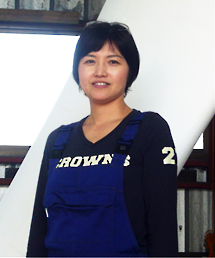 |
|
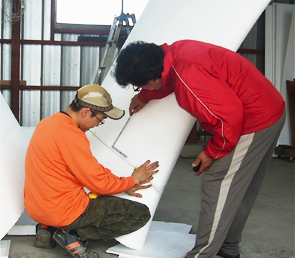 |
| Tomoko Konoike. Photo by Alan Gleason |
|
Shionoya (right) and Morita (left) check the measurements of a Styrofoam sculpture mockup. The actual work will eventually be cast in aluminum. Photo by Alan Gleason
All images courtesy of Tomoko Konoike |